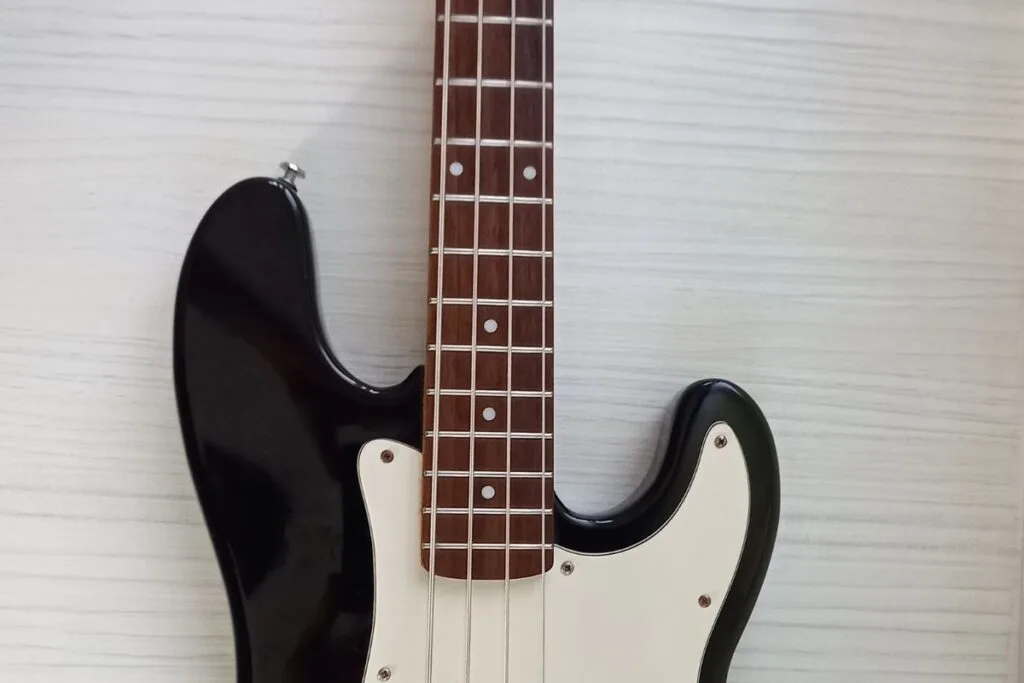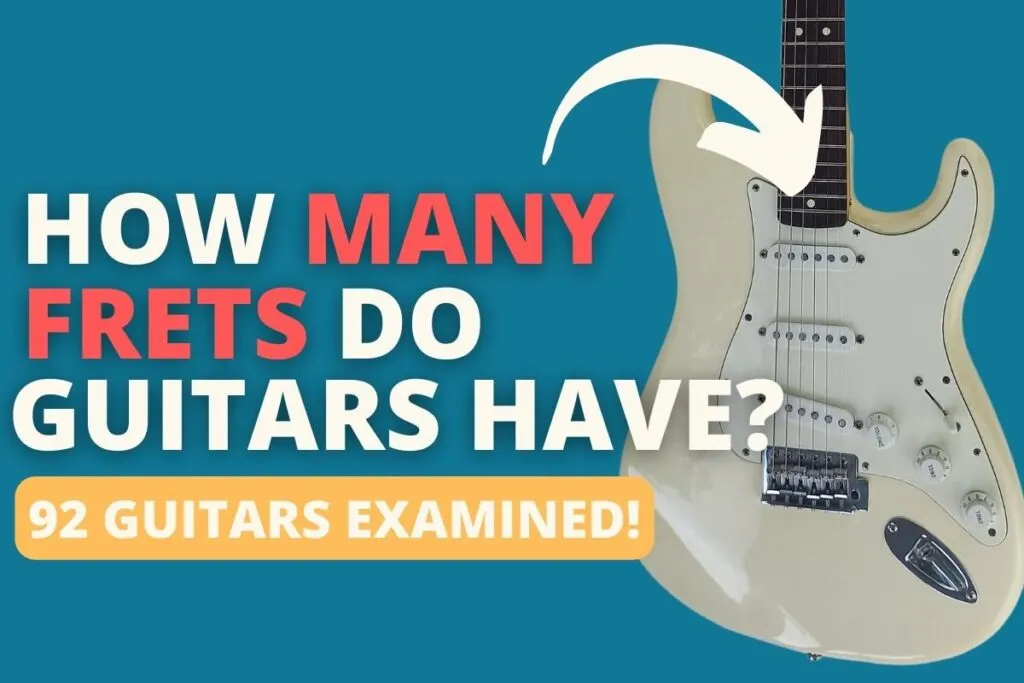The number of frets that your guitar has can really affect how you play. Knowing how many frets a guitar has before buying it is essential to ensuring that you have the room and notes available for your preferred playing style.
I’ve looked at the most popular models of electric, acoustic, bass, and classical guitars to bring you a detailed resource on how many frets a guitar has – and how this affects you.
How many frets are on an electric guitar?
Knowing the number of frets that an electric guitar has is important. It can help you decide which guitar is best for you and your style of playing.
Most modern electric guitars have 22 frets. There are, however, models with a different amount of frets available.
But why do different guitars have a different amount of frets? Well, a guitar that has 22 frets may be great for a guitarist of a rock band, but someone who plays heavy metal may need some more frets for shredding higher notes.
Not only this, but even similar models of a guitar can have a different number of frets! In fact, my Fender American Standard Stratocaster has 22 frets, whereas my “Made in Mexico” Stratocaster has 21.
So, it’s important to double-check the specific guitar model with the manufacturer before buying!

The number of frets on popular electric guitar models
Here’s a list of the number of frets of popular electric guitar models. When I say frets, I mean playable frets. Every guitar has a small amount of excess fretboard at the end, commonly mistaken for a fret, but it’s not playable.
| Electric guitar model | Number of frets |
|---|---|
| Epiphone Les Paul Classic | 22 |
| Epiphone Les Paul Prophecy | 24 |
| Epiphone Les Paul Standard | 22 |
| Epiphone Les Paul Studio | 22 |
| Fender American Original Jazzmaster | 21 |
| Fender American Original Stratocaster | 21 |
| Fender American Original Telecaster | 21 |
| Fender American Performer Jazzmaster | 22 |
| Fender American Performer Mustang | 22 |
| Fender American Performer Stratocaster | 22 |
| Fender American Performer Telecaster | 22 |
| Fender American Professional II Stratocaster | 22 |
| Fender American Professional II Telecaster | 22 |
| Fender American Professional Jazzmaster | 22 |
| Fender American Ultra Stratocaster | 22 |
| Fender American Ultra Telecaster | 22 |
| Fender Player Jaguar | 22 |
| Fender Player Jazzmaster | 22 |
| Fender Player Mustang | 22 |
| Fender Player Stratocaster | 22 |
| Fender Player Telecaster | 22 |
| Fender Squier Affinity Series Stratocaster | 21 |
| Fender Squier Bullet Stratocaster | 21 |
| Fender Squier Classic Vibe Stratocaster | 21 |
| Fender Vintera Jaguar | 22 |
| Fender Vintera Jazzmaster | 21 |
| Fender Vintera Mustang | 22 |
| Fender Vintera Stratocaster | 21 |
| Fender Vintera Telecaster | 21 |
| Gibson ES-335 | 22 |
| Gibson Flying V | 22 |
| Gibson Les Paul Classic | 22 |
| Gibson Les Paul Modern | 22 |
| Gibson Les Paul Standard | 22 |
| Gibson Les Paul Studio | 22 |
| Gibson Les Paul Tribute | 22 |
| Ibanez RG550 | 24 |
| Ibanez RG565 | 24 |
| PRS SE Custom 24 | 24 |
| PRS SE Hollowbody Standard | 22 |
| Yamaha Pacifica 112V | 22 |
How many frets are on an acoustic guitar?
Acoustic guitarists have different requirements from electric guitarists. Typically, there’s less focus on the higher end of the fretboard for acoustic playing. As a result of this, acoustic guitars tend to have fewer frets than electric guitars.
Most modern acoustic guitars have 20 frets, though there are some variances across different models.
I’ve created the below table showing the number of frets on some popular models of acoustic guitars.
| Acoustic guitar model | Number of frets |
|---|---|
| Epiphone DR-100 | 20 |
| Epiphone J-45 | 20 |
| Fender American Acoustasonic Stratocaster | 22 |
| Fender American Acoustasonic Telecaster | 22 |
| Fender CC-60S Concert | 20 |
| Fender CD-60S Dreadnought | 20 |
| Fender FSR CD-60 | 20 |
| Gibson G-45 Standard | 20 |
| Gibson Hummingbird Standard | 20 |
| Gibson J-45 Standard | 20 |
| Gibson J-45 Studio | 20 |
| Gibson L-00 Standard | 19 |
| Gibson SJ-200 | 20 |
| Gibson Songwriter Standard | 20 |
| Martin D-28 | 20 |
| Martin LX1E Little Martin | 20 |
| Martin SC-13E | 20 |
| Ovation AB24II-HB | 20 |
| Ovation CE44P-SM | 23* |
| Ovation CS24-5 | 20 |
| Sigma SE Series GTCE | 20 |
| Taylor 110e | 20 |
| Taylor 724ce | 20 |
| Taylor GS Mini | 20 |
| Yamaha F310 | 20 |
| Yamaha FG800 | 20 |
*The Ovation CE44P-SM has 23 frets, but only for the higher strings as the fretboard is cut at an angle.
Which acoustic guitars have the most frets?
According to my research, the Ovation CE44P-SM is the acoustic guitar with the most frets. This acoustic rocks an astounding 23 frets – much higher than the 20 fret average!
These frets are clearly designed for solo work, as the fretboard is cut at such an angle that they’re only accessible on the higher strings. If you’re looking for an acoustic guitar with plenty of range, this looks like a solid choice.
How many frets do bass guitars have?
Bass guitars are often overshadowed by the electric guitar but they are just as essential to modern western music.
On average, bass guitars tend to have 20 frets. As ever, there are some models with more and with less. Most range between 19 and 22 frets – and there are some models with even more!

I put together the below table showing the number of frets on some popular models of bass guitars.
| Bass guitar model | Number of frets |
|---|---|
| Epiphone EB-3 SG | 20 |
| Fender American Original 50s Precision Bass | 20 |
| Fender American Performance Precision Bass | 20 |
| Fender American Professional II Precision Bass | 20 |
| Fender Player Jaguar Bass | 20 |
| Fender Player Jazz Bass | 20 |
| Fender Player Precision Bass | 20 |
| Fender Vintera 50’s Precision Bass | 20 |
| Fender Vintera 60’s Mustang Bass | 19 |
| Gibson Thunderbird IV | 20 |
| Ibanez SR500M | 22 |
| MusicMan Stingray Special | 22 |
| Rickenbacker 4003 | 20 |
| Squier Affinity Bronco Bass | 19 |
| Squier Classic Vibe Bass | 20 |
| Sterling SUB Ray4 | 21 |
| Yamaha TRBX304 | 24 |
Popular bass guitars, like the Fender Jazz and Precision, have almost as many frets as a standard electric guitar, both coming in at 20 frets. This is the same for iconic bass models the Rickenbacker 4003 and Gibson Thunderbird IV.
Models like the Ibanez SR500M and Yamaha TRBX304 have 24 frets, which will give you some extra notes at the top end for contemporary playing styles.
How many frets are on a classical guitar?
Classical guitars are the foundation for all modern guitar types. Back in the day (“the day” meaning the 18th century), these guitars didn’t have as many frets. As classical guitars grew in popularity, the techniques used to play them also grew more advanced, making added frets necessary for the guitarist who wanted to play higher notations. However, the highest fret is usually partly cut away to fit perfectly with the sound hole on the body.
Modern classical guitars have around 19 frets on average. The range appears to be between 17 and 20 for full-sized classical guitars.
| Classical guitar model | Number of frets |
|---|---|
| Fender ESC-110 | 18 |
| Ibanez GA6CE | 19 |
| Martin 000C12-16E | 20 |
| Startone CG 851 | 19 |
| Taylor 814ce-N | 20 |
| Taylor Academy 12e-N | 17 |
| Yamaha C40 | 20 |
| Yamaha CGS102AII | 19 |
| Yamaha SLG200NW | 19 |
Classical guitars have thicker necks and bulkier build, ideal for specific western chord progressions providing enough space for resonation to take place when picking the strings individually. Due to its thicker build, the point of connection between the neck and the body is the 12th fret making higher notes challenging to play, but not impossible.
Are there classical guitars available with more frets?
It’s important to remember that guitars have grown extremely popular in a short period, resulting in many alterations to industry standards. As such, many manufacturers are offering classical guitars with 20 frets.
Does the number of frets matter?
For beginner guitarists, the fret count is insignificant at first. Sure, you’ll want to emulate your guitar heroes and shred incredible solos – but you’ll mostly learn the fundamental patterns in the first position, which is close to the first fret. Advanced players require higher frets as it makes higher notes playable on the neck instead of having to bend the strings to those notes.
Fret counts, especially on electric guitars, become more of a concern as guitarists develop their skill and style. Thousands of professional guitar players (myself included) don’t even play the frets past the 20th, whereas others specifically purchased guitars with more frets for certain songs.
From a technical point of view, higher notes have less sustain but are much sharper. If the guitar pickups also need to be pushed back to make space for added frets on the body, the sound will also be brighter as the strings have more tension near the end. A larger neck accommodating more frets will also add to the overall size of the guitar, which can make it harder to play.
Which style uses the most frets?
Progressive musicians deliberately push the boundaries of standard music and often use all the frets, especially the higher ones, to differentiate themselves from the norm.
Progressive instrumental guitarists, such as Michael Angelo Batio and Yngwie Malmsteen, often use more frets to create variation and distinction in their compositions. In addition, metal music shares a lot of traits with classical music, and complex melody lines played across various scales, and different positions are a trademark of the genre. This style of music is called “neo-classical”.
Conclusion
Electric guitars have the highest fret count, between 20-24 frets on average, of any guitar, and custom build options are available for more advanced players. The fret count is not a major concern for the beginner guitarist. Still, as the techniques develop, higher frets are needed to create variation and distinction, as playing the higher frets requires a lot of skill and discipline.


Conor is a music producer, multi-instrumentalist, and all-round enthusiast from the UK with over 15 years of experience. He’s the founder and sole-content creator for the roundtable audio blog and YouTube channel.
